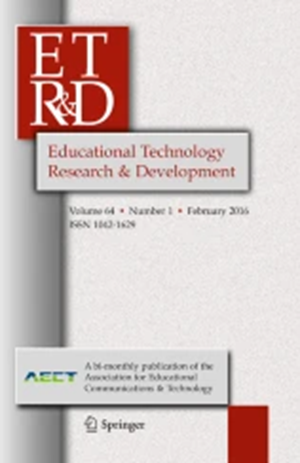编织:通过编织的青少年数学参与的变化
IF 4.2
3区 教育学
Q1 EDUCATION & EDUCATIONAL RESEARCH
Etr&d-Educational Technology Research and Development
Pub Date : 2023-11-06
DOI:10.1007/s11423-023-10316-y
引用次数: 0
摘要
尽管最近在数学方面努力支持传统上少数族裔背景的学习者,但数学成绩和参与方面的不平等仍然存在,特别是对女性和有色人种而言。此外,学校里教授数学的方式与西方数学家和哲学家的特定认识论相一致。虽然编织与数学之间的紧密联系已经确立,但探索这种联系在支持青少年在教育环境中多元参与数学方面的可能性的研究较少。因此,我们的问题是:在一个以制作为中心的干预中,旨在让青少年接触到编织中固有的数学实践,学生创造的人工制品如何展示学习?本文通过四个案例,展示了中学青少年学习编织和通过编织学习是如何尝试或提升他们的计划或实施设计的。他们的学习过程展示了对数学的投入,反映了更有经验的编织者。让青少年通过编织来参与数学活动,这可能是建立框架和课堂活动的一步,通过努力解决这些学科问题。本文章由计算机程序翻译,如有差异,请以英文原文为准。

Weaving in: shifts in youth mathematical engagement through weaving
Abstract Despite recent efforts to support learners from traditionally minoritized backgrounds in mathematics, inequities in math achievement and participation still exist, particularly for women and people of color. Additionally, much of how math is taught in schools aligns with a particular epistemology that comes from western mathematicians and philosophers. While a strong link between weaving and mathematics has been established, fewer studies explore the possibilities of this link for supporting youth’s pluralistic engagement with mathematics in educational settings. Thus, we ask: In a making-focused intervention designed to expose youth to the mathematical practices inherent in weaving, how do student-created artifacts showcase learning? In this paper, four cases demonstrate how middle-school youth learning to weave and learning through weaving experimented or leveled up their planned or implemented designs. Their learning processes showcase engagement with mathematics that mirrors that of more experienced weavers. Making visible the mathematical engagement that youth undertake through weaving may be a step toward building frameworks and classroom activities through making that work to combat these disciplinary issues.
求助全文
通过发布文献求助,成功后即可免费获取论文全文。
去求助
来源期刊

Etr&d-Educational Technology Research and Development
EDUCATION & EDUCATIONAL RESEARCH-
CiteScore
10.70
自引率
4.00%
发文量
94
期刊介绍:
Educational Technology Research and Development is the only scholarly journal in the field focusing entirely on research and development in educational technology.
The Research Section assigns highest priority in reviewing manuscripts to rigorous original quantitative, qualitative, or mixed methods studies on topics relating to applications of technology or instructional design in educational settings. Such contexts include K-12, higher education, and adult learning (e.g., in corporate training settings). Analytical papers that evaluate important research issues related to educational technology research and reviews of the literature on similar topics are also published. This section features well-documented articles on the practical aspects of research as well as applied theory in educational practice and provides a comprehensive source of current research information in instructional technology.
The Development Section publishes research on planning, implementation, evaluation and management of a variety of instructional technologies and learning environments. Empirically based formative evaluations and theoretically based instructional design research papers are welcome, as are papers that report outcomes of innovative approaches in applying technology to instructional development. Papers for the Development section may involve a variety of research methods and should focus on one aspect of the instructional development process or more; when relevant and possible, papers should discuss the implications of instructional design decisions and provide evidence linking outcomes to those decisions.
The Cultural and Regional Perspectives Section (formerly International Review) welcome s innovative research about how technologies are being used to enhance learning, instruction, and performance specific to a culture or region. Educational technology studies submitted to this section should be situated in cultural contexts that critically examine issues and ideologies prevalent in the culture or region or by individuals or groups in the culture or region. Theoretical perspectives can be broadly based and inclusive of research, such as critical race theory, cultural-historical activity theory, and cultural models. Papers published in this section include quantitative, qualitative, and mixed-methods articles and reviews drawing on relevant theories, empirical evidence, and critical analyses of the findings, implications, and conclusions within a cultural context.
Educational Technology Research and Development publishes special issues on timely topics of interest to the community, in addition to regular papers.
 求助内容:
求助内容: 应助结果提醒方式:
应助结果提醒方式:


